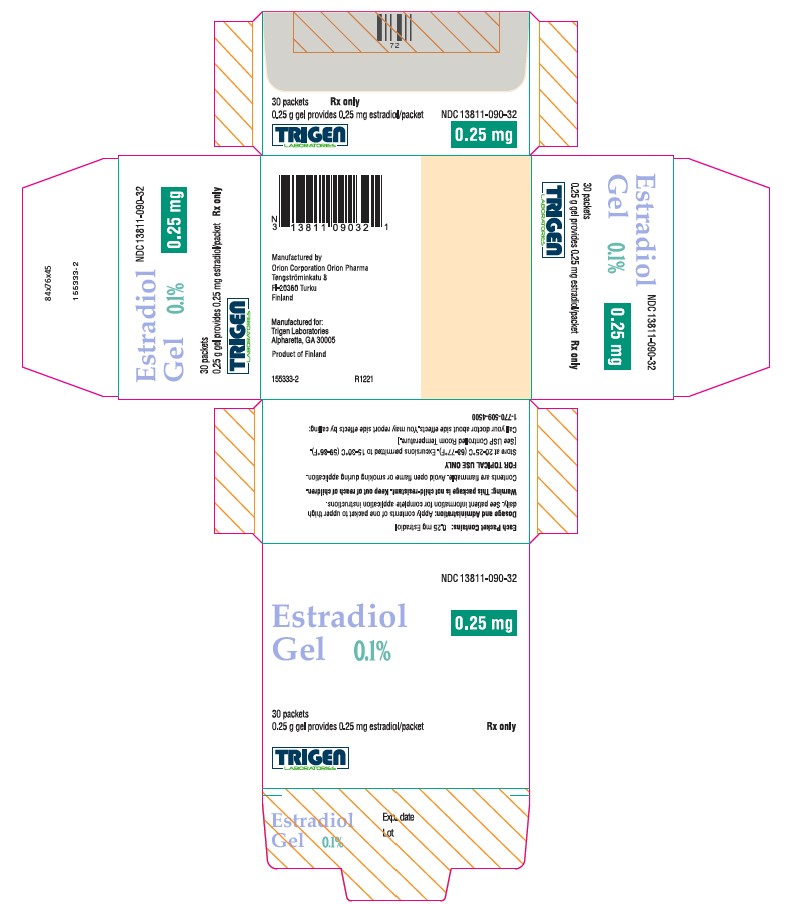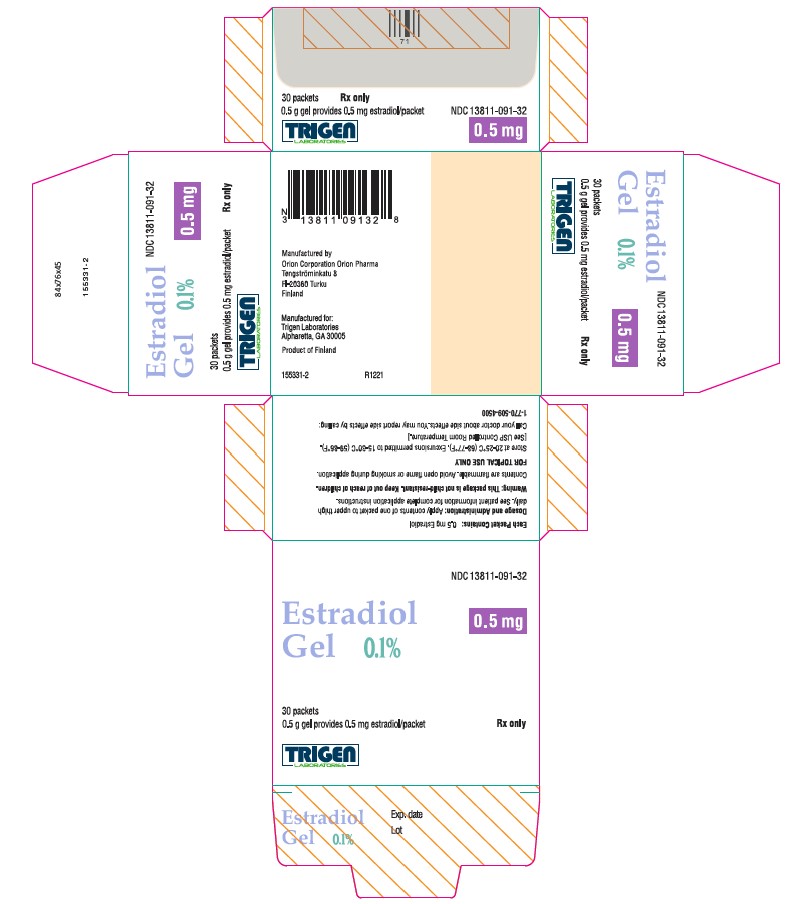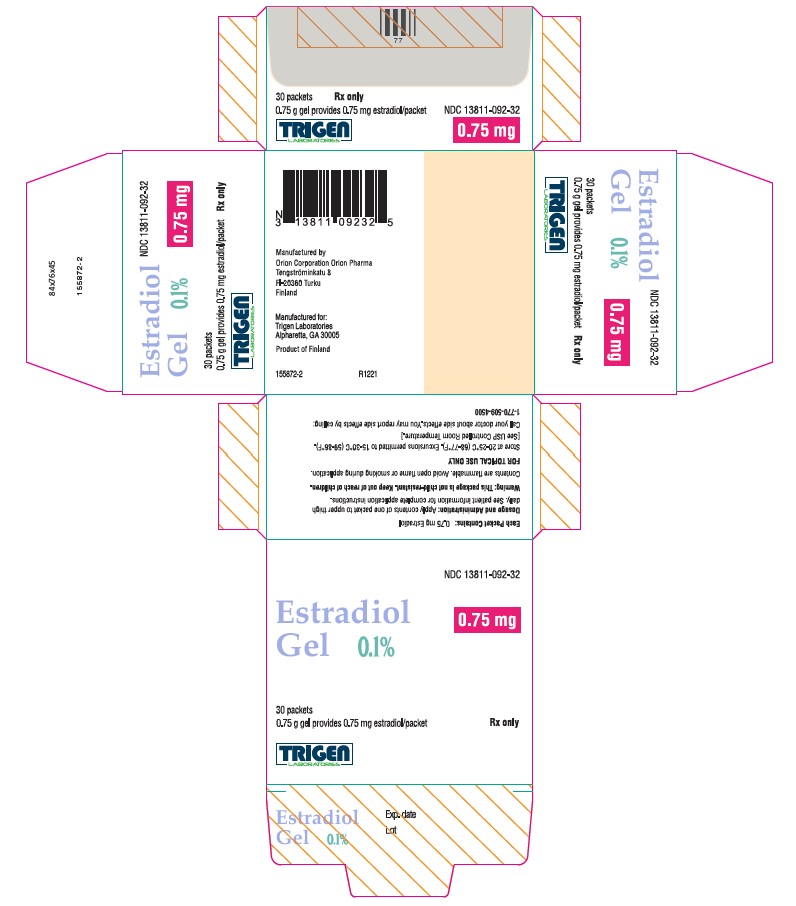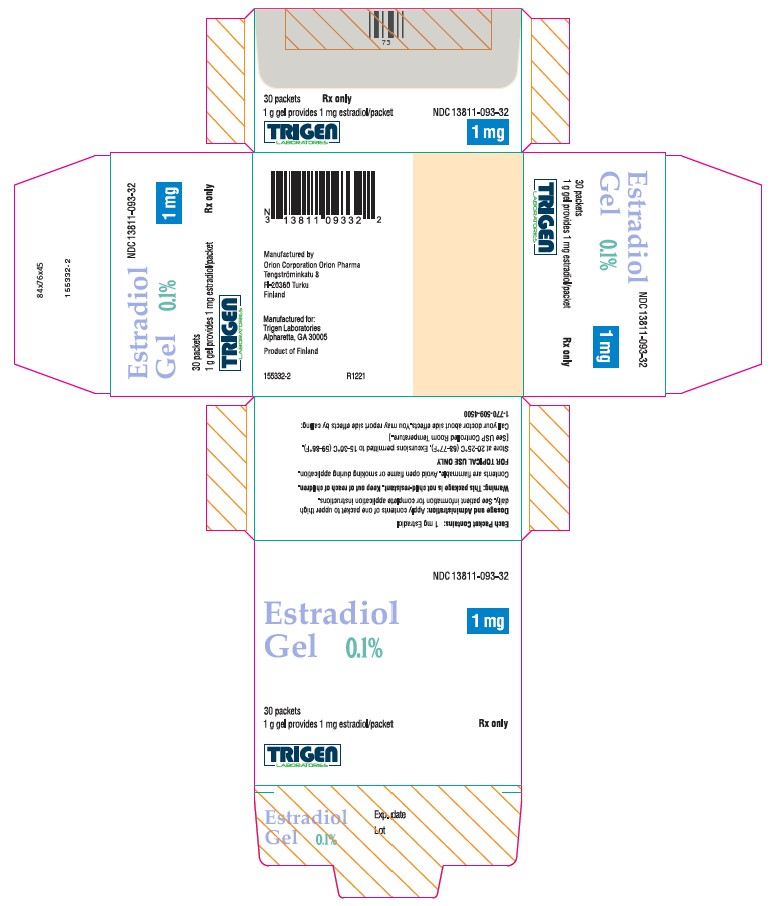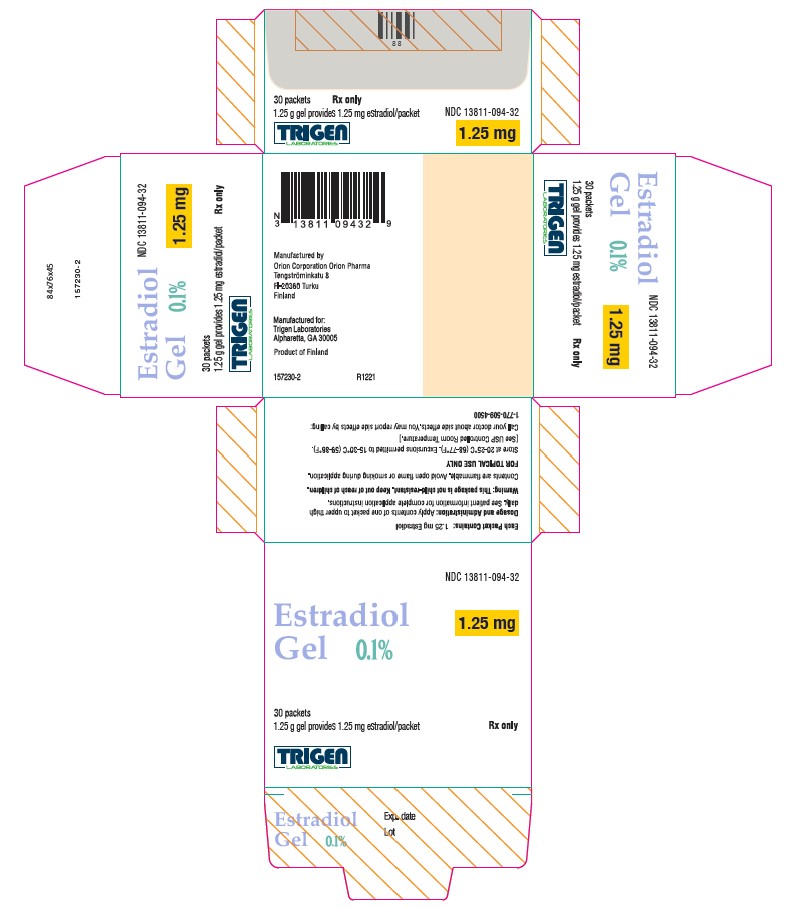Estradiol by Trigen Laboratories, LLC ESTRADIOL gel
Estradiol by
Drug Labeling and Warnings
Estradiol by is a Prescription medication manufactured, distributed, or labeled by Trigen Laboratories, LLC. Drug facts, warnings, and ingredients follow.
Drug Details [pdf]
-
HIGHLIGHTS OF PRESCRIBING INFORMATION
These highlights do not include all the information needed to use Estradiol Gel safely and effectively. See full prescribing information for Estradiol Gel.
Estradiol Gel, for topical use
Initial U.S. Approval: 1975WARNING: ENDOMETRIAL CANCER, CARDIOVASCULAR DISORDERS, PROBABLE DEMENTIA and BREAST CANCER
See full prescribing information for complete boxed warning.
Estrogen-Alone Therapy
- There is an increased risk of endometrial cancer in a woman with a uterus who uses unopposed estrogens (5.2)
- The Women’s Health Initiative (WHI) estrogen-alone substudy reported increased risks of stroke and deep vein thrombosis (DVT) (5.1)
- The WHI Memory Study (WHIMS) estrogen-alone ancillary study of WHI reported an increased risk of probable dementia in postmenopausal women 65 years of age and older (5.3)
- Do not use estrogen-alone therapy for the prevention of cardiovascular disease or dementia (5.1, 5.3)
Estrogen Plus Progestin Therapy
- The WHI estrogen plus progestin substudy reported increased risks of pulmonary embolism (PE), DVT, stroke, and myocardial infarction (MI) (5.1)
- The WHI estrogen plus progestin study reported increased risks of invasive breast cancer (5.2)
- The WHIMS estrogen plus progestin ancillary study of WHI reported an increased risk of probable dementia in postmenopausal women 65 years of age and older (5.3)
- Do not use estrogen plus progestogen therapy for the prevention of cardiovascular disease or dementia (5.1, 5.3)
RECENT MAJOR CHANGES
Warnings and Precautions, Malignant Neoplasms (5.2) 11/2023
INDICATIONS AND USAGE
Estradiol gel is an estrogen indicated for the treatment of moderate to severe vasomotor symptoms due to menopause (1.1).
DOSAGE AND ADMINISTRATION
Daily administration of 0.25 to 1.25 grams of estradiol gel to the right or left upper thigh on alternating days. Women should be started with the lowest effective dose and the dose should be evaluated periodically (2).
DOSAGE FORMS AND STRENGTHS
Gel: 0.25, 0.5, 0.75, 1.0, and 1.25 gram-filled single-dose foil packets containing 0.25, 0.5, 0.75, 1.0, and 1.25 mg estradiol, respectively (3)
CONTRAINDICATIONS
- Undiagnosed abnormal genital bleeding (4)
- Breast cancer or a history of breast cancer (4, 5.2)
- Estrogen-dependent neoplasia (4, 5.2)
- Active DVT, PE, or history of these conditions (4, 5.1)
- Active arterial thromboembolic disease (e.g., stroke and MI), or history of these conditions (4, 5.1)
- Known anaphylactic reaction, angioedema, or hypersensitivity to estradiol gel (4)
- Hepatic impairment or disease (4, 5.10)
- Protein C, protein S, or antithrombin deficiency, or other known thrombophilic disorders (4)
WARNINGS AND PRECAUTIONS
ADVERSE REACTIONS
The most common adverse reactions (incidence >5 percent and greater than placebo) in any estradiol gel treatment group are metrorrhagia, breast tenderness, vaginal mycosis, nasopharyngitis, and upper respiratory tract infection (6.1).
To report SUSPECTED ADVERSE REACTIONS, contact TRIGEN LABORATORIES, LLC at 1-800-444-5164 or FDA at 1-800-FDA-1088 or www.fda.gov/medwatch.
DRUG INTERACTIONS
- Inducers and inhibitors of CYP3A4 may affect estrogen drug metabolism and decrease or increase the estrogen plasma concentration (7).
See 17 for PATIENT COUNSELING INFORMATION and FDA-approved patient labeling.
Revised: 11/2023
-
Table of Contents
FULL PRESCRIBING INFORMATION: CONTENTS*
WARNING: ENDOMETRIAL CANCER, CARDIOVASCULAR DISORDERS, PROBABLE DEMENTIA and BREAST CANCER
RECENT MAJOR CHANGES
1 INDICATIONS AND USAGE
1.1 Treatment of Moderate to Severe Vasomotor Symptoms due to Menopause
2 DOSAGE AND ADMINISTRATION
2.1 Treatment of Moderate to Severe Vasomotor Symptoms due to Menopause
3 DOSAGE FORMS AND STRENGTHS
4 CONTRAINDICATIONS
5 WARNINGS AND PRECAUTIONS
5.1 Cardiovascular Disorders
5.2 Malignant Neoplasms
5.3 Probable Dementia
5.4 Gallbladder Disease
5.5 Hypercalcemia
5.6 Visual Abnormalities
5.7 Addition of a Progestogen When a Woman Has Not Had a Hysterectomy
5.8 Elevated Blood Pressure
5.9 Exacerbation of Hypertriglyceridemia
5.10 Hepatic Impairment and/or Past History of Cholestatic Jaundice
5.11 Exacerbation of Hypothyroidism
5.12 Fluid Retention
5.13 Hypocalcemia
5.14 Exacerbation of Endometriosis
5.15 Hereditary Angioedema
5.16 Exacerbation of Other Conditions
5.17 Photosensitivity
5.18 Application of Sunscreen and Topical Solutions
5.19 Flammability of Alcohol-Based Gels
5.20 Potential for Estradiol Transfer and Effects of Washing
5.21 Laboratory Tests
5.22 Drug-Laboratory Test Interactions
6 ADVERSE REACTIONS
6.1 Clinical Trials Experience
6.2 Postmarketing Experience
7 DRUG INTERACTIONS
8 USE IN SPECIFIC POPULATIONS
8.1 Pregnancy
8.2 Lactation
8.4 Pediatric Use
8.5 Geriatric Use
10 OVERDOSAGE
11 DESCRIPTION
12 CLINICAL PHARMACOLOGY
12.1 Mechanism of Action
12.2 Pharmacodynamics
12.3 Pharmacokinetics
13 NONCLINICAL TOXICOLOGY
13.1 Carcinogenesis, Mutagenesis, and Impairment of Fertility
14 CLINICAL STUDIES
14.1 Effects on Vasomotor Symptoms in Postmenopausal Women
14.2 Women's Health Initiative Studies
14.3 Women's Health Initiative Memory Study
15 REFERENCES
16 HOW SUPPLIED/STORAGE AND HANDLING
16.1 How Supplied
16.2 Storage and Handling
17 PATIENT COUNSELING INFORMATION
- * Sections or subsections omitted from the full prescribing information are not listed.
-
BOXED WARNING
(What is this?)
WARNING: ENDOMETRIAL CANCER, CARDIOVASCULAR DISORDERS, PROBABLE DEMENTIA and BREAST CANCER
Estrogen-Alone Therapy
Endometrial Cancer
There is an increased risk of endometrial cancer in a woman with a uterus who uses unopposed estrogens. Adding a progestogen to estrogen therapy has been shown to reduce the risk of endometrial hyperplasia, which may be a precursor to endometrial cancer. Perform adequate diagnostic measures, including directed or random endometrial sampling when indicated, to rule out malignancy in postmenopausal women with undiagnosed persistent or recurring abnormal genital bleeding [see Warnings and Precautions (5.2)].
Cardiovascular Disorders and Probable Dementia
The Women's Health Initiative (WHI) estrogen-alone substudy reported increased risks of stroke and deep vein thrombosis (DVT) in postmenopausal women (50 to 79 years of age) during 7.1 years of treatment with daily oral conjugated estrogens (CE) [0.625 mg]-alone, relative to placebo [see Warnings and Precautions (5.1), and Clinical Studies (14.2)].
The WHI Memory Study (WHIMS) estrogen-alone ancillary study of WHI reported an increased risk of developing probable dementia in postmenopausal women 65 years of age and older during 5.2 years of treatment with daily CE (0.625 mg)-alone, relative to placebo. It is unknown whether this finding applies to younger postmenopausal women [see Warnings and Precautions (5.3), Use in Specific Populations (8.5), and Clinical Studies (14.3)].
Do not use estrogen-alone therapy for the prevention of cardiovascular disease or dementia [see Warnings and Precautions (5.1, 5.3), and Clinical Studies (14.2, 14.3)].
Only daily oral 0.625 mg CE was studied in the estrogen-alone substudy of the WHI. Therefore, the relevance of the WHI findings regarding adverse cardiovascular events and dementia to lower CE doses, other routes of administration, or other estrogen-alone products is not known. Without such data, it is not possible to definitively exclude these risks or determine the extent of these risks for other products. Discuss with your patient the benefits and risks of estrogen-alone therapy, taking into account her individual risk profile.
Prescribe estrogens with or without progestogens at the lowest effective doses and for the shortest duration consistent with treatment goals and risks for the individual woman.
Estrogen Plus Progestin Therapy
Cardiovascular Disorders and Probable Dementia
The WHI estrogen plus progestin substudy reported increased risks of pulmonary embolism (PE), DVT, stroke, and myocardial infarction (MI) in postmenopausal women (50 to 79 years of age) during 5.6 years of treatment with daily oral CE (0.625 mg) combined with medroxyprogesterone acetate (MPA) [2.5 mg], relative to placebo [see Warnings and Precautions (5.1), and Clinical Studies (14.2)].
The WHIMS estrogen plus progestin ancillary study of the WHI reported an increased risk of developing probable dementia in postmenopausal women 65 years of age and older during 4 years of treatment with daily CE (0.625 mg) combined with MPA (2.5 mg), relative to placebo. It is unknown whether this finding applies to younger postmenopausal women [see Warnings and Precautions (5.3), Use in Specific Populations (8.5), and Clinical Studies (14.3)].
Do not use estrogen plus progestogen therapy for the prevention of cardiovascular disease or dementia [see Warnings and Precautions (5.1, 5.3), and Clinical Studies (14.2, 14.3)].
Breast Cancer
The WHI estrogen plus progestin substudy demonstrated an increased risk of invasive breast cancer [see Warnings and Precautions (5.2), and Clinical Studies (14.2)].
Only daily oral 0.625 mg CE and 2.5 mg MPA were studied in the estrogen plus progestin substudy of the WHI. Therefore, the relevance of the WHI findings regarding adverse cardiovascular events, dementia, and breast cancer to lower CE plus other MPA doses, other routes of administration, or other estrogen plus progestogen products is not known. Without such data, it is not possible to definitively exclude these risks or determine the extent of these risks for other products. Discuss with your patient the benefits and risks of estrogen plus progestogen therapy, taking into account her individual risk profile.
Prescribe estrogens with or without progestogens at the lowest effective doses and for the shortest duration consistent with treatment goals and risks for the individual woman.
- 1 INDICATIONS AND USAGE
-
2 DOSAGE AND ADMINISTRATION
Generally, when estrogen is prescribed for a postmenopausal woman with a uterus, consider addition of a progestogen to reduce the risk of endometrial cancer.
Generally, a woman without a uterus, does not need a progestogen in addition to her estrogen therapy. In some cases, however, hysterectomized women who have a history of endometriosis may need a progestogen [see Warnings and Precautions (5.2, 5.14)].
Use estrogen-alone, or in combination with a progestogen, at the lowest effective dose and for the shortest duration consistent with treatment goals and risks for the individual woman. Reevaluate postmenopausal women periodically as clinically appropriate to determine whether treatment is still necessary.
2.1 Treatment of Moderate to Severe Vasomotor Symptoms due to Menopause
Start therapy with the 0.25 grams applied once daily on the skin of either the right or left upper thigh. Adjust the dose up to a maximum of 1.25 grams, as needed.
The application surface area should be about 5 by 7 inches (approximately the size of two palm prints). The entire contents of a unit dose packet should be applied each day. To avoid potential skin irritation, apply estradiol gel to the right or left upper thigh on alternating days. Do not apply estradiol gel on the face, breasts, or irritated skin or in or around the vagina. Allow gel to dry after application before dressing. Do not wash the application site within 1 hour after applying estradiol gel. Avoid contact of the gel with eyes. Wash hands after application.
- 3 DOSAGE FORMS AND STRENGTHS
-
4 CONTRAINDICATIONS
Estradiol gel is contraindicated in women with any of the following conditions:
- Undiagnosed abnormal genital bleeding [see Warning and Precautions (5.2)]
- Breast cancer or history of breast cancer [see Warning and Precautions (5.2)]
- Estrogen-dependent neoplasia [see Warning and Precautions (5.2)]
- Active DVT, PE, or history of these conditions [see Warning and Precautions (5.1)]
- Active arterial thromboembolic disease (e.g., stroke and MI), or a history of these conditions [see Warning and Precautions (5.1)]
- Known anaphylactic reaction, angioedema, or hypersensitivity to estradiol gel
- Hepatic impairment or disease
- Protein C, protein S, or antithrombin deficiency, or other known thrombophilic disorders
-
5 WARNINGS AND PRECAUTIONS
5.1 Cardiovascular Disorders
Increased risks of stroke and DVT are reported with estrogen-alone therapy. Increased risk of PE, DVT, stroke and MI are reported with estrogen plus progestin therapy.
Immediately discontinue estrogen with or without progestogen therapy if any of these occur or are suspected.
Manage appropriately any risk factors for arterial vascular disease (e.g., hypertension, diabetes mellitus, tobacco use, hypercholesterolemia, and obesity) and/or venous thromboembolism (VTE) (e.g., personal history or family history of VTE, obesity, and systemic lupus erythematosus).
Stroke
The WHI estrogen-alone substudy reported a statistically significant increased risk of stroke in women 50 to 79 years of age receiving daily CE (0.625 mg)-alone compared to women in the same age group receiving placebo (45 versus 33 strokes per 10,000 women-years, respectively). The increase in risk was demonstrated in year 1 and persisted [see Clinical Studies (14.2)]. Immediately discontinue estrogen-alone therapy if a stroke occurs or is suspected.
Subgroup analyses of women 50 to 59 years of age suggest no increased risk of stroke for those women receiving CE (0.625 mg)-alone versus those receiving placebo (18 versus 21 per 10,000 women-years).1
The WHI estrogen plus progestin substudy reported a statistically significant increased risk of stroke in women 50 to 79 years of age receiving daily CE (0.625 mg) plus MPA (2.5 mg) compared to women in the same age group receiving placebo (33 versus 25 per 10,000 women-years, respectively) [see Clinical Studies (14.2)]. The increase in risk was demonstrated after the first year and persisted.1 Immediately discontinue estrogen plus progestogen therapy if a stroke occurs or is suspected.
Coronary Heart Disease
The WHI estrogen-alone substudy reported no overall effect on coronary heart disease (CHD) events (defined as nonfatal MI, silent MI, or CHD death) in women receiving estrogen-alone compared to placebo2 [see Clinical Studies (14.2)].
Subgroup analyses of women 50 to 59 years of age, who were less than 10 years since menopause, suggest a reduction (not statistically significant) of CHD events in those women receiving daily CE (0.625 mg)-alone compared to placebo (8 versus 16 per 10,000 women-years).1
The WHI estrogen plus progestin substudy reported an increased risk (not statistically significant) of CHD events in those women receiving daily CE (0.625 mg) plus MPA (2.5 mg) compared to women receiving placebo (41 versus 34 per 10,000 women-years).1 An increase in relative risk was demonstrated in year 1, and a trend toward decreasing relative risk was reported in years 2 through 5 [see Clinical Studies (14.2)].
In postmenopausal women with documented heart disease (n=2,763), average 66.7 years of age, in a controlled clinical trial of secondary prevention of cardiovascular disease [Heart and Estrogen/Progestin Replacement Study (HERS)], treatment with daily CE (0.625 mg) plus MPA (2.5 mg) demonstrated no cardiovascular benefit. During an average follow-up of 4.1 years, treatment with CE plus MPA did not reduce the overall rate of CHD events in postmenopausal women with established coronary heart disease. There were more CHD events in the CE plus MPA-treated group than in the placebo group in year 1, but not during the subsequent years. Two thousand, three hundred and twenty-one (2,321) women from the original HERS trial agreed to participate in an open label extension of HERS, HERS II. Average follow-up in HERS II was an additional 2.7 years, for a total of 6.8 years overall. Rates of CHD events were comparable among women in the CE (0.625 mg) plus MPA (2.5 mg) group and the placebo group in HERS, HERS II, and overall.
Venous Thromboembolism
In the WHI estrogen-alone substudy, the risk of VTE (DVT and PE) was increased for women receiving daily CE (0.625 mg)-alone compared to placebo (30 versus 22 per 10,000 women-years), although only the increased risk of DVT reached statistical significance (23 versus 15 per 10,000 women-years). The increase in VTE risk was demonstrated during the first 2 years3 [see Clinical Studies (14.2)]. Immediately discontinue estrogen-alone therapy if a VTE occurs or is suspected.
The WHI estrogen plus progestin substudy reported a statistically significant 2-fold greater rate of VTE in women receiving daily CE (0.625 mg) plus MPA (2.5 mg) compared to women receiving placebo (35 versus 17 per 10,000 women-years). Statistically significant increases in risk for both DVT (26 versus 13 per 10,000 women-years) and PE (18 versus 8 per 10,000 women-years) were also demonstrated. The increase in VTE risk was demonstrated during the first year and persisted4 [see Clinical Studies (14.2)]. Immediately discontinue estrogen plus progestogen therapy if a VTE occurs or is suspected.
If feasible, discontinue estrogens at least 4 to 6 weeks before surgery of the type associated with an increased risk of thromboembolism, or during periods of prolonged immobilization.
5.2 Malignant Neoplasms
Endometrial Cancer
An increased risk of endometrial cancer has been reported with the use of unopposed estrogen therapy in a woman with a uterus. The reported endometrial cancer risk among unopposed estrogen users is about 2- to 12-fold greater than in non-users, and appears dependent on duration of treatment and on estrogen dose. Most studies show no significant increased risk associated with use of estrogens for less than 1 year. The greatest risk appears associated with prolonged use, with increased risk of 15- to 24-fold for 5 to 10 years or more and this risk has been shown to persist for at least 8 to 15 years after estrogen therapy is discontinued.
Clinical surveillance of all women using estrogen-alone or estrogen plus progestogen therapy is important. Perform adequate diagnostic measures, including directed or random endometrial sampling when indicated, to rule out malignancy in postmenopausal women with undiagnosed persistent or recurring abnormal genital bleeding with unknown etiology. There is no evidence that the use of natural estrogens results in a different endometrial risk profile than synthetic estrogens of equivalent estrogen dose. Adding a progestogen to postmenopausal estrogen therapy in postmenopausal women has been shown to reduce the risk of endometrial hyperplasia, which may be a precursor to endometrial cancer.
Breast Cancer
The WHI substudy of daily CE (0.625 mg)-alone provided information about breast cancer in estrogen-alone users. In the WHI estrogen-alone substudy, after an average follow-up of 7.1 years, daily CE-alone was not associated with an increased risk of invasive breast cancer [relative risk (RR) 0.80] compared to placebo5 [see Clinical Studies (14.2)].
After a mean follow-up of 5.6 years, the WHI substudy of daily CE (0.625 mg) plus MPA (2.5 mg) reported an increased risk of invasive breast cancer in women who took daily CE plus MPA compared to placebo. In this substudy, prior use of estrogen-alone or estrogen plus progestin therapy was reported by 26 percent of the women. The relative risk of invasive breast cancer was 1.24, and the absolute risk was 41 versus 33 cases per 10,000 women-years, for CE plus MPA compared with placebo. Among women who reported prior use of hormone therapy, the relative risk of invasive breast cancer was 1.86, and the absolute risk was 46 versus 25 cases per 10,000 women-years, for CE plus MPA compared with placebo. Among women who reported no prior use of hormone therapy, the relative risk of invasive breast cancer was 1.09, and the absolute risk was 40 versus 36 cases per 10,000 women-years for CE plus MPA compared with placebo. In the same substudy, invasive breast cancers were larger, were more likely to be node positive, and were diagnosed at a more advanced stage in the CE (0.625 mg) plus MPA (2.5 mg) group compared with the placebo group. Metastatic disease was rare, with no apparent difference between the two groups. Other prognostic factors such as histologic subtype, grade and hormone receptor status did not differ between the groups6 [see Clinical Studies (14.2)].
Consistent with the WHI clinical trial, observational studies have also reported an increased risk of breast cancer with estrogen plus progestin therapy, and a smaller increase in the risk for breast cancer with estrogen-alone therapy, after several years of use. One large meta-analysis of prospective cohort studies reported increased risks that were dependent upon duration of use and could last up to >10 years after discontinuation of estrogen plus progestin therapy and estrogen-alone therapy. Extension of the WHI trials also demonstrated increased breast cancer risk associated with estrogen plus progestin therapy. Observational studies also suggest that the risk of breast cancer was greater, and became apparent earlier, with estrogen plus progestin therapy as compared to estrogen-alone therapy.
These studies have not generally found significant variation in the risk of breast cancer among different estrogen plus progestin combinations, doses, or routes of administration.
The use of estrogen-alone and estrogen plus progestin has been reported to result in an increase in abnormal mammograms requiring further evaluation.
Have all women receive yearly breast examinations by a healthcare provider and perform monthly breast self-examinations. In addition, base the scheduling of mammography examinations on patient age, risk factors, and prior mammogram results.
Ovarian Cancer
The CE plus MPA substudy of WHI reported that estrogen plus progestin increased the risk of ovarian cancer. After an average follow-up of 5.6 years, the relative risk for CE plus MPA versus placebo was 1.58 (95 percent CI, 0.77–3.24), but was not statistically significant.The absolute risk for CE plus MPA versus placebo was 4 versus 3 cases per 10,000 women-years.7
A meta-analysis of 17 prospective and 35 retrospective epidemiology studies found that women who used hormonal therapy for menopausal symptoms had an increased risk for ovarian cancer. The primary analysis, using case-control comparisons, included 12,110 cancer cases from the 17 prospective studies. The relative risks associated with current use of hormonal therapy was 1.41 (95% confidence interval [CI] 1.32 to 1.50); there was no difference in the risk estimates by duration of the exposure (less than 5 years [median of 3 years] vs. greater than 5 years [median of 10 years] of use before the cancer diagnosis). The relative risk associated with combined current and recent use (discontinued use within 5 years before cancer diagnosis) was 1.37 (95% CI 1.27-1.48), and the elevated risk was significant for both estrogen-alone and estrogen plus progestin products. The exact duration of hormone therapy use associated with an increased risk of ovarian cancer, however, is unknown.
5.3 Probable Dementia
In the WHI Memory Study (WHIMS) estrogen-alone ancillary study, a population of 2,947 hysterectomized women 65 to 79 years of age was randomized to daily CE (0.625 mg)-alone or placebo.
After an average follow-up of 5.2 years, 28 women in the estrogen-alone group and 19 women in the placebo group were diagnosed with probable dementia. The relative risk of probable dementia for CE- alone versus placebo was 1.49 (95 percent CI, 0.83–2.66). The absolute risk of probable dementia for CE-alone versus placebo was 37 versus 25 cases per 10,000 women-years8 [see Use in Specific Populations (8.5), and Clinical Studies (14.3)].
In the WHIMS estrogen plus progestin ancillary study, a population of 4,532 postmenopausal women 65 to 79 years of age was randomized to daily CE (0.625 mg) plus MPA (2.5 mg) or placebo.
After an average follow-up of 4 years, 40 women in the CE plus MPA group and 21 women in the placebo group were diagnosed with probable dementia. The relative risk of probable dementia for CE plus MPA versus placebo was 2.05 (95 percent CI, 1.21–3.48). The absolute risk of probable dementia for CE plus MPA versus placebo was 45 versus 22 cases per 10,000 women-years8 [see Use in Specific Populations (8.5), and Clinical Studies (14.3)].
When data from the two populations in the WHIMS estrogen-alone and estrogen plus progestin ancillary studies were pooled as planned in the WHIMS protocol, the reported overall relative risk for probable dementia was 1.76 (95 percent CI, 1.19–2.60). Since both ancillary studies were conducted in women 65 to 79 years of age, it is unknown whether these findings apply to younger postmenopausal women8 [see Use in Specific Populations (8.5), and Clinical Studies (14.3)].
5.4 Gallbladder Disease
A 2- to 4-fold increase in the risk of gallbladder disease requiring surgery in postmenopausal women receiving estrogens has been reported.
5.5 Hypercalcemia
Estrogen administration may lead to severe hypercalcemia in women with breast cancer and bone metastases. Discontinue estrogens, including estradiol gel, if hypercalcemia occurs, and take appropriate measures to reduce the serum calcium level.
5.6 Visual Abnormalities
Retinal vascular thrombosis has been reported in patients receiving estrogens. Discontinue estradiol gel pending examination if there is sudden partial or complete loss of vision, or a sudden onset of proptosis, diplopia, or migraine. Permanently discontinue estrogens, including estradiol gel, if examination reveals papilledema or retinal vascular lesions.
5.7 Addition of a Progestogen When a Woman Has Not Had a Hysterectomy
Studies of the addition of a progestogen for 10 or more days of a cycle of estrogen administration, or daily with estrogen in a continuous regimen, have reported a lowered incidence of endometrial hyperplasia than would be induced by estrogen treatment alone. Endometrial hyperplasia may be a precursor to endometrial cancer.
There are, however, possible risks that may be associated with the use of progestogens with estrogens compared to estrogen-alone regimens. These include an increased risk of breast cancer.
5.8 Elevated Blood Pressure
In a small number of case reports, substantial increases in blood pressure have been attributed to idiosyncratic reactions to estrogens. In a large, randomized, placebo-controlled clinical trial, a generalized effect of estrogens on blood pressure was not seen.
5.9 Exacerbation of Hypertriglyceridemia
In women with pre-existing hypertriglyceridemia, estrogen therapy may be associated with elevations of plasma triglycerides leading to pancreatitis. Discontinue estradiol gel if pancreatitis occurs.
5.10 Hepatic Impairment and/or Past History of Cholestatic Jaundice
Estrogens may be poorly metabolized in women with hepatic impairment. Exercise caution in any woman with a history of cholestatic jaundice associated with past estrogen use or with pregnancy. In the case of recurrence of cholestatic jaundice, discontinue estradiol gel.
5.11 Exacerbation of Hypothyroidism
Estrogen administration leads to increased thyroid-binding globulin (TBG) levels. Women with normal thyroid function can compensate for the increased TBG by making more thyroid hormone, thus maintaining free T4 and T3 serum concentrations in the normal range. Women dependent on thyroid hormone replacement therapy who are also receiving estrogens may require increased doses of their thyroid replacement therapy. Monitor thyroid function in these women during treatment with estradiol gel to maintain their free thyroid hormone levels in an acceptable range.
5.12 Fluid Retention
Estrogens may cause some degree of fluid retention. Monitor any woman with a condition(s) that might predispose her to fluid retention, such as a cardiac or renal impairment. Discontinue estrogen-alone therapy, including estradiol gel, with evidence of medically concerning fluid retention.
5.13 Hypocalcemia
Estrogen-induced hypocalcemia may occur in women with hypoparathyroidism. Consider whether the benefits of estrogen therapy outweigh the risks in such women.
5.14 Exacerbation of Endometriosis
A few cases of malignant transformation of residual endometrial implants have been reported in women treated post-hysterectomy with estrogen-alone therapy. Consider the addition of a progestogen therapy for a woman known to have residual endometriosis post-hysterectomy.
5.15 Hereditary Angioedema
Exogenous estrogens may exacerbate symptoms of angioedema in women with hereditary angioedema. Consider whether the benefits of estrogen therapy, including estradiol gel, outweigh the risks in such women.
5.16 Exacerbation of Other Conditions
Estrogen therapy, including estradiol gel, may cause an exacerbation of asthma, diabetes mellitus, epilepsy, migraine, porphyria, systemic lupus erythematosus, and hepatic hemangiomas. Consider whether the benefits of estrogen therapy outweigh the risks in women with such conditions.
5.17 Photosensitivity
The effects of direct sun exposure to estradiol gel application sites have not been evaluated in clinical trials.
5.18 Application of Sunscreen and Topical Solutions
Studies conducted using other approved topical estrogen gel products have shown that sunscreens have the potential for changing the systemic exposure of topically applied estrogen gels.
The effect of sunscreens and other topical lotions on the systemic exposure of estradiol gel has not been evaluated in clinical trials.
5.19 Flammability of Alcohol-Based Gels
Alcohol based gels are flammable. Avoid fire, flame, or smoking until estradiol gel has dried.
Occlusion of the area where the topical drug product is applied with clothing or other barriers is not recommended until estradiol gel has completely dried.
5.20 Potential for Estradiol Transfer and Effects of Washing
There is a potential for drug transfer from one individual to the other following physical contact of estradiol gel application sites. In a study to evaluate transferability to males from their female contacts, there was some elevation of estradiol levels over baseline in the male subjects; however, the degree of transferability in this study was inconclusive. Women are advised to avoid skin contact with other persons until the gel is completely dried. The site of application should be covered (clothed) after drying.
Washing the application site with soap and water 1 hour after application resulted in a 30 to 38 percent decrease in the mean total 24‑hour exposure to estradiol. Therefore, women should refrain from washing the application site for at least one hour after application.
5.21 Laboratory Tests
Serum follicle stimulating hormone (FSH) and estradiol levels are not useful in the management of moderate to severe vasomotor symptoms.
5.22 Drug-Laboratory Test Interactions
- Accelerated prothrombin time, partial thromboplastin time, and platelet aggregation time; increased platelet count; increased factors II, VII antigen, VIII antigen, VIII coagulant activity, IX, X, XII, VII-X complex, II-VII-X complex, and beta-thromboglobulin; decreased levels of anti-factor Xa and antithrombin III, decreased antithrombin III activity; increased levels of fibrinogen and fibrinogen activity; increased plasminogen antigen and activity.
- Increased thyroid binding globulin (TBG) levels leading to increased circulating total thyroid hormone levels, as measured by protein-bound iodine (PBI), T4 levels (by column or by radioimmunoassay) or T3 levels by radioimmunoassay. T3 resin uptake is decreased, reflecting the elevated TBG. Free T4 and free T3 concentrations are unaltered. Women on thyroid replacement therapy may require higher doses of thyroid hormone.
- Other binding proteins may be elevated in serum, for example, corticosteroid binding globulin (CBG), sex hormone-binding globulin (SHBG), leading to increased total circulating corticosteroids and sex steroids, respectively. Free hormone concentrations, such as testosterone and estradiol, may be decreased. Other plasma proteins may be increased (angiotensinogen/renin substrate, alpha-l-antitrypsin, ceruloplasmin).
- Increased plasma high-density lipoprotein (HDL) and HDL2 cholesterol subfraction concentrations, reduced low-density lipoprotein (LDL) cholesterol concentration, increased triglyceride levels.
- Impaired glucose tolerance.
-
6 ADVERSE REACTIONS
The following serious adverse reactions are discussed elsewhere in the labeling:
- Cardiovascular Disorders [see Boxed Warning, Warnings and Precautions (5.1)].
- Malignant Neoplasms [see Boxed Warning, Warnings and Precautions (5.2)].
6.1 Clinical Trials Experience
Because clinical trials are conducted under widely varying conditions, adverse reaction rates observed in the clinical trials of a drug cannot be directly compared to rates in the clinical trials of another drug and may not reflect the rates observed in practice.
Estradiol gel was studied at doses of 0.25, 0.5 and 1.0 gram per day in a 12-week, double-blind, placebo-controlled study that included a total of 495 postmenopausal women (86.5 percent Caucasian). The adverse reactions that occurred at a rate greater than 5 percent and greater than placebo in any of the treatment groups are summarized in Table 1.
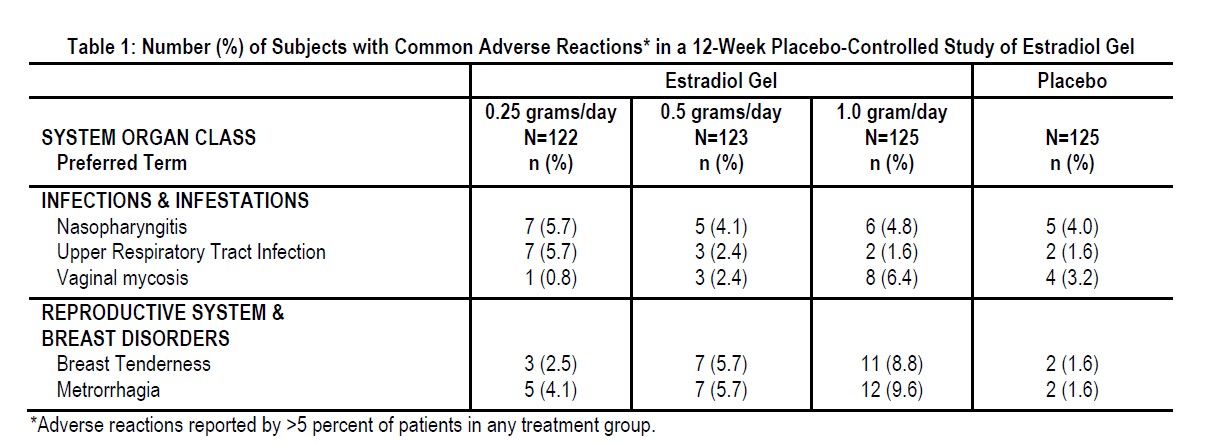
In a 12-week placebo-controlled study of estradiol gel, application site reactions were seen in <1 percent of participating women.
6.2 Postmarketing Experience
The following adverse reactions have been identified during post-approval use of estradiol gel. Because these reactions are reported voluntarily from a population of uncertain size, it is not always possible to reliably estimate their frequency or establish a causal relationship to drug exposure.
Genitourinary System
Amenorrhea, dysmenorrhea, ovarian cyst, vaginal discharge
Breasts
Gynecomastia
Cardiovascular
Palpitations, ventricular extrasystoles
Gastrointestinal
Flatulence
Skin
Rash pruritic, urticaria
Eyes
Retinal vein occlusion
Central Nervous System
Tremor
Miscellaneous
Arthralgia, application site rash, asthenia, chest discomfort, fatigue, feeling abnormal, heart rate increased, insomnia, malaise, muscle spasms, pain in extremity, weight increased
-
7 DRUG INTERACTIONS
In vitro and in vivo studies have shown that estrogens are metabolized partially by cytochrome P450 3A4 (CYP3A4). Therefore, inducers or inhibitors of CYP3A4 may affect estrogen drug metabolism. Inducers of CYP3A4, such as St. John's wort (Hypericum perforatum) preparations, phenobarbital, carbamazepine, and rifampin, may reduce plasma concentrations of estrogens, possibly resulting in a decrease in therapeutic effects and/or changes in the uterine bleeding profile. Inhibitors of CYP3A4, such as erythromycin, clarithromycin, ketoconazole, itraconazole, ritonavir, and grapefruit juice, may increase plasma concentrations of estrogens and result in adverse reactions.
-
8 USE IN SPECIFIC POPULATIONS
8.1 Pregnancy
Risk Summary
Estradiol gel is not indicated for use in pregnant women. There are no data with the use of Estradiol Gel in pregnant women; however, epidemiologic studies and meta-analyses have not found an increased risk of genital or nongenital birth defects (including cardiac anomalies and limb-reduction defects) following exposure to combined hormonal contraceptives (estrogen and progestins) before conception or during early pregnancy.
In the U.S. general population, the estimated background risk of major birth defects and miscarriage in clinically recognized pregnancies is 2% to 4% and 15% to 20%, respectively.
8.2 Lactation
Risk Summary
Estrogens are present in human milk and can reduce milk production in breast-feeding women. This reduction can occur at any time but is less likely to occur once breast-feeding is well established.
The developmental and health benefits of breastfeeding should be considered along with the mother’s clinical need for estradiol gel and any potential adverse effects on the breastfed child from estradiol gel or from the underlying maternal condition.
8.4 Pediatric Use
Estradiol gel is not indicated for use in pediatric patients. Clinical studies have not been conducted in the pediatric population.
8.5 Geriatric Use
There have not been sufficient numbers of geriatric women involved in studies utilizing estradiol gel to determine whether those over 65 years of age differ from younger subjects in their response to estradiol gel.
The Women's Health Initiative Studies
In the WHI estrogen-alone substudy (daily CE [0.625 mg]-alone versus placebo), there was a higher relative risk of stroke in women greater than 65 years of age [see Warnings and Precautions (5.1), and Clinical Studies (14.2)].
In the WHI estrogen plus progestin substudy (daily CE [0.625 mg] plus MPA [2.5 mg] versus placebo), there was a higher relative risk of nonfatal stroke and invasive breast cancer in women greater than 65 years of age [see Warnings and Precautions (5.1, 5.2), and Clinical Studies (14.2)].
The Women's Health Initiative Memory Study
In the WHIMS ancillary studies of postmenopausal women 65 to 79 years of age, there was an increased risk of developing probable dementia in women receiving estrogen-alone or estrogen plus progestin when compared to placebo [see Warnings and Precautions (5.3), and Clinical Studies (14.3)].
Since both ancillary studies were conducted in women 65 to 79 years of age, it is unknown whether these findings apply to younger postmenopausal women8 [see Warnings and Precautions (5.3), and Clinical Studies (14.3)].
- 10 OVERDOSAGE
-
11 DESCRIPTION
Estradiol gel 0.1 percent, is a clear, colorless gel, which is odorless when dry. It is designed to deliver sustained circulating concentrations of estradiol when applied once daily to the skin. The gel is applied to a small area (200 cm2) of the thigh in a thin layer. Estradiol gel is available in five doses of 0.25, 0.5, 0.75, 1.0, and 1.25 grams for topical application (corresponding to 0.25, 0.5, 0.75, 1.0, and 1.25 mg estradiol, respectively).
The active component of the topical gel is estradiol.
Estradiol is a white crystalline powder, chemically described as estra-1,3,5(10)-triene-3,17ß-diol. It has an empirical formula of C18H24O2 and molecular weight of 272.39. The structural formula is:
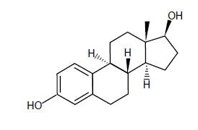
The remaining components of the gel (carbomer, ethanol, propylene glycol, purified water, and triethanolamine) are pharmacologically inactive.
-
12 CLINICAL PHARMACOLOGY
12.1 Mechanism of Action
Endogenous estrogens are largely responsible for the development and maintenance of the female reproductive system and secondary sexual characteristics. Although circulating estrogens exist in a dynamic equilibrium of metabolic interconversions, estradiol is the principal intracellular human estrogen and is substantially more potent than its metabolites, estrone and estriol, at the receptor level.
The primary source of estrogen in normally cycling adult women is the ovarian follicle, which secretes 70 to 500 mcg of estradiol daily, depending on the phase of the menstrual cycle. After menopause, most endogenous estrogen is produced by conversion of androstenedione, which is secreted by the adrenal cortex, to estrone in the peripheral tissues. Thus, estrone and the sulfate conjugated form, estrone sulfate, are the most abundant circulating estrogens in postmenopausal women.
Estrogens act through binding to nuclear receptors in estrogen-responsive tissues. To date, two estrogen receptors have been identified. These vary in proportion from tissue to tissue.
Circulating estrogens modulate the pituitary secretion of the gonadotropins, luteinizing hormone (LH) and FSH, through a negative feedback mechanism. Estrogens act to reduce the elevated levels of these hormones seen in postmenopausal women.
12.2 Pharmacodynamics
Generally, a serum estrogen concentration does not predict an individual woman’s therapeutic response to estradiol gel nor her risk for adverse outcomes. Likewise, exposure comparisons across different estrogen products to infer efficacy or safety for the individual woman may not be valid.
12.3 Pharmacokinetics
Absorption
Estradiol diffuses across intact skin and into the systemic circulation by a passive absorption process, with diffusion across the stratum corneum being the rate-limiting factor.
In a 14-day, Phase 1, multiple-dose study, estradiol gel demonstrated linear and approximately dose- proportional estradiol pharmacokinetics at steady state for both AUC0-24 and Cmax following once daily dosing to the skin of either the right or left upper thigh (Table 2).

Steady-state serum concentration of estradiol are achieved by day 12 following daily application of estradiol gel to the skin of the upper thigh. The mean (SD) serum estradiol levels following once daily dosing at day 14 are shown in Figure 1.
Figure 1: Mean (SD) Serum Estradiol Concentrations (Values Uncorrected for Baseline) on Day 14 Following Multiple Daily Doses of Estradiol Gel 0.1%
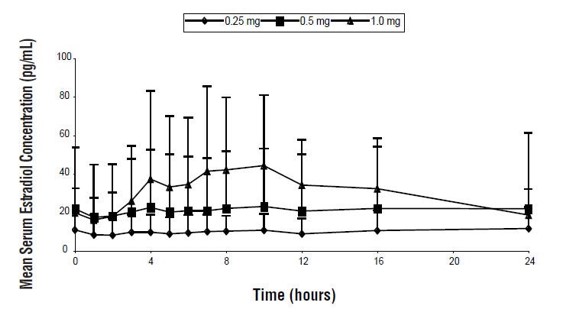
The effect of sunscreens and other topical lotions on the systemic exposure of estradiol gel has not been evaluated. Studies conducted using topical estrogen gel approved products have shown that sunscreens have the potential for changing the systemic exposure of topically applied estrogen gels.
Distribution
The distribution of exogenous estrogens is similar to that of endogenous estrogens. Estrogens are widely distributed in the body and are generally found in higher concentrations in the sex hormone target organs. Estrogens circulate in the blood largely bound to SHBG and albumin.
Metabolism
Exogenous estrogens are metabolized in the same manner as endogenous estrogens. Circulating estrogens exist in a dynamic equilibrium of metabolic interconversions. These transformations take place mainly in the liver. Estradiol is converted reversibly to estrone, and both can be converted to estriol, which is a major urinary metabolite. Estrogens also undergo enterohepatic recirculation via sulfate and glucuronide conjugation in the liver, biliary secretion of conjugates into the intestine, and hydrolysis in the intestine followed by reabsorption. In postmenopausal women, a significant proportion of the circulating estrogens exist as sulfate conjugates, especially estrone sulfate, which serves as a circulating reservoir for the formation of more active estrogens.
Although the clinical significance has not been determined, estradiol from estradiol gel does not undergo first pass metabolism and provides estradiol to estrone ratios at steady state in the range of 0.42 to 0.65.
Excretion
Estradiol, estrone, and estriol are excreted in the urine along with glucuronide and sulfate conjugates. The apparent terminal half-life for estradiol was about 10 hours following administration of estradiol gel.
Potential for Estradiol Transfer
The effect of estradiol transfer was evaluated in healthy postmenopausal women who topically applied 1.0 gram of estradiol gel (single dose) on one thigh. One and 8 hours after gel application, they engaged in direct thigh-to-arm contact with a partner for 15 minutes. While some elevation of estradiol levels over baseline was seen in the male subjects, the degree of transferability in this study was inconclusive.
Effects of Washing
The effect of application site washing on skin surface levels and serum concentrations of estradiol was determined in 16 healthy postmenopausal women after application of 1.0 gram of estradiol gel to a 200 cm2 area on the thigh. Washing the application site with soap and water 1 hour after application removed all detectable amounts of estradiol from the surface of the skin and resulted in a 30 to 38 percent decrease in the mean total 24-hour exposure to estradiol.
- 13 NONCLINICAL TOXICOLOGY
-
14 CLINICAL STUDIES
14.1 Effects on Vasomotor Symptoms in Postmenopausal Women
A randomized, double-blind, placebo-controlled trial evaluated the efficacy of 12-week treatment with three different daily doses of estradiol gel for vasomotor symptoms in 495 postmenopausal women (86.5 percent White; 10.1 percent Black) between 34 and 89 years of age (mean age 54.6) who had at least 50 moderate to severe hot flushes per week at baseline (2-week period prior to treatment). Women applied placebo, estradiol gel 0.25 grams (0.25 mg estradiol), estradiol gel 0.5 grams (0.5 mg estradiol) or estradiol gel 1.0 gram (1.0 mg estradiol) once daily to the thigh. Reductions in both the median daily frequency and the median daily severity of moderate to severe hot flushes were statistically significant for the 0.5 grams per day and the 1.0 gram per day estradiol gel doses when compared to placebo at week 4. Statistically significant reductions in both the median daily frequency and the median daily severity of moderate to severe hot flushes for the estradiol gel 0.25 grams per day dose when compared to placebo were delayed to week 7. There were statistically significant reductions in median daily frequency and severity of hot flushes for all three estradiol gel doses (0.25 grams per day, 0.5 grams per day and 1.0 gram per day) compared to placebo at week 12. See Table 3 for results.
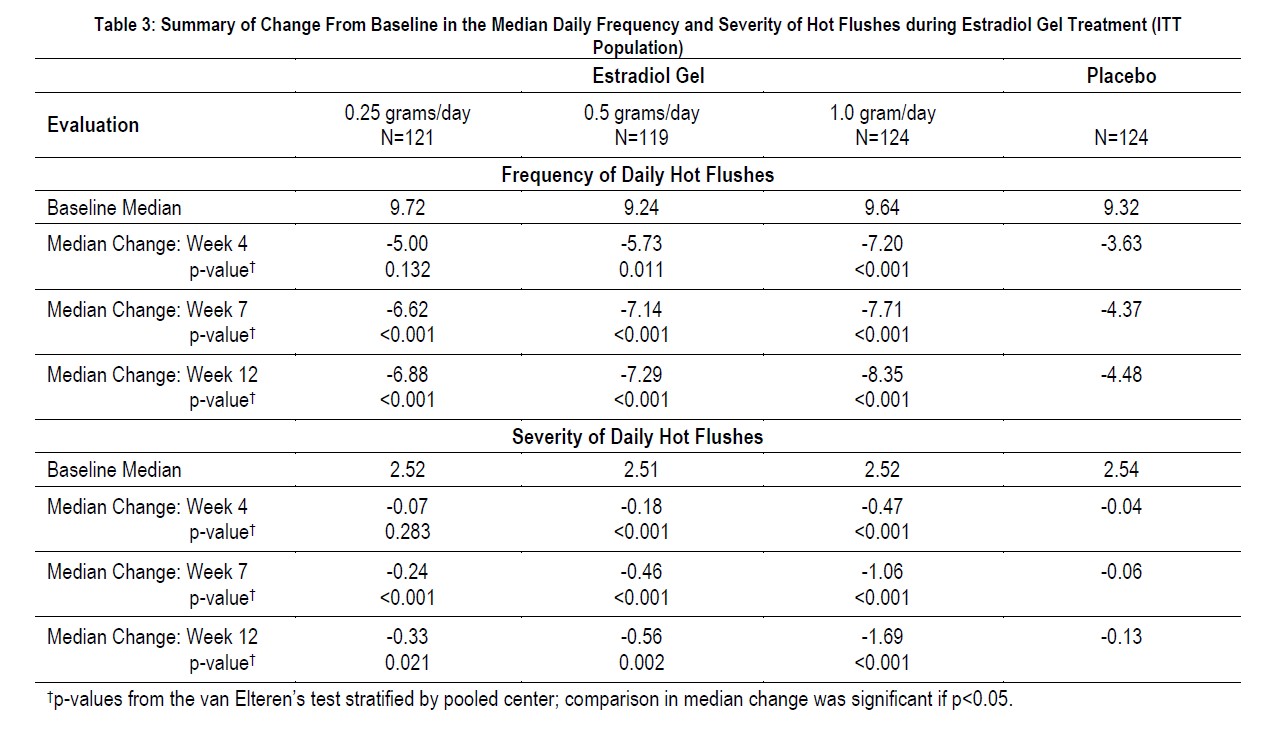
14.2 Women's Health Initiative Studies
The WHI enrolled approximately 27,000 predominantly healthy postmenopausal women in two substudies to assess the risks and benefits of daily oral CE (0.625 mg)-alone or in combination with MPA (2.5 mg) compared to placebo in the prevention of certain chronic diseases. The primary endpoint was the incidence of CHD (defined as nonfatal MI, silent MI and CHD death), with invasive breast cancer as the primary adverse outcome. A "global index" included the earliest occurrence of CHD, invasive breast cancer, stroke, PE, endometrial cancer (only in the CE plus MPA substudy), colorectal cancer, hip fracture, or death due to other cause. These substudies did not evaluate the effects of CE- alone or CE plus MPA on menopausal symptoms.
WHI Estrogen-Alone Substudy
The WHI estrogen-alone substudy was stopped early because an increased risk of stroke was observed, and it was deemed that no further information would be obtained regarding the risks and benefits of estrogen-alone in predetermined primary endpoints. Results of the estrogen-alone substudy, which included 10,739 women (average 63 years of age, range 50 to 79; 75.3 percent White, 15.1 percent Black, 6.1 percent Hispanic, 3.6 percent Other), after an average follow-up of 7.1 years are presented in Table 4.
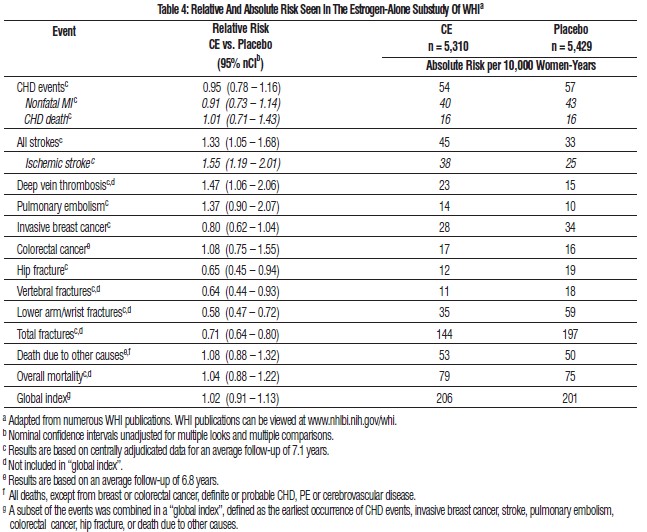
For those outcomes included in the WHI "global index" that reached statistical significance, the absolute excess risk per 10,000 women-years in the group treated with CE-alone was 12 more strokes, while the absolute risk reduction per 10,000 women-years was 7 fewer hip fractures.9 The absolute excess risk of events included in the "global index" was a nonsignificant 5 events per 10,000 women- years. There was no difference between the groups in terms of all-cause mortality.
No overall difference for primary CHD events (nonfatal MI, silent MI and CHD death) and invasive breast cancer incidence in women receiving CE-alone compared with placebo was reported in final centrally adjudicated results from the estrogen-alone substudy, after an average follow-up of 7.1 years. See Table 4.
Centrally adjudicated results for stroke events from the estrogen-alone substudy, after an average follow-up of 7.1 years, reported no significant difference in distribution of stroke subtype or severity, including fatal strokes, in women receiving CE-alone compared to placebo. Estrogen-alone increased the risk for ischemic stroke, and this excess risk was present in all subgroups of women examined.10
Timing of the initiation of estrogen-alone therapy relative to the start of menopause may affect the overall risk benefit profile. The WHI estrogen-alone substudy stratified by age showed in women 50 to 59 years of age a non-significant trend toward reduced risk for CHD [hazard ratio (HR) 0.63 (95 percent CI, 0.36–1.09)] and overall mortality [HR 0.71 (95 percent CI, 0.46–1.11)].
WHI Estrogen Plus Progestin Substudy
The WHI estrogen plus progestin substudy was stopped early. According to the predefined stopping rule, after an average follow-up of 5.6 years of treatment, the increased risk of breast cancer and cardiovascular events exceeded the specified benefits included in the "global index." The absolute excess risk of events included in the "global index" was 19 per 10,000 women-years.
For those outcomes included in the WHI "global index" that reached statistical significance after 5.6 years of follow-up, the absolute excess risks per 10,000 women-years in the group treated with CE plus MPA were 7 more CHD events, 8 more strokes, 10 more PEs, and 8 more invasive breast cancers, while the absolute risk reductions per 10,000 women-years were 6 fewer colorectal cancers and 5 fewer hip fractures.
Results of the CE plus MPA substudy, which included 16,608 women (average 63 years of age, range 50 to 79; 83.9 percent White, 6.8 percent Black, 5.4 percent Hispanic, 3.9 percent Other), are presented in Table 5. These results reflect centrally adjudicated data after an average follow-up of 5.6 years.
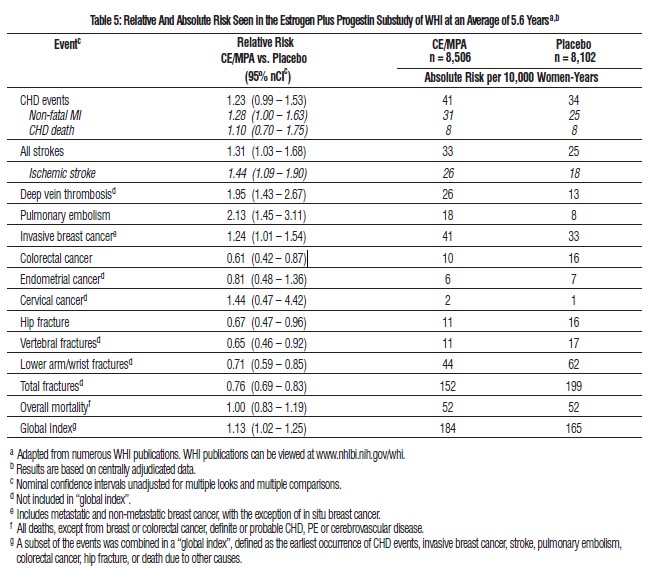
Timing of the initiation of estrogen plus progestin therapy relative to the start of menopause may affect the overall risk benefit profile. The WHI estrogen plus progestin substudy stratified for age showed in women 50 to 59 years of age a non-significant trend toward reduced risk for overall mortality [HR 0.69 (95 percent CI, 0.44–1.07)].
14.3 Women's Health Initiative Memory Study
The WHIMS estrogen-alone ancillary study of WHI enrolled 2,947 predominantly healthy hysterectomized postmenopausal women 65 to 79 years of age (45 percent were 65 to 69 year of age, 36 percent were 70 to 74 years of age, and 19 percent were 75 years of age and older) to evaluate the effects of daily CE (0.625 mg)-alone on the incidence of probable dementia (primary outcome) compared to placebo.
After an average follow-up of 5.2 years, the relative risk of probable dementia for CE-alone versus placebo was 1.49 (95 percent CI, 0.83–2.66). The absolute risk of probable dementia for CE-alone versus placebo was 37 versus 25 cases per 10,000 women-years. Probable dementia as defined in this study included Alzheimer disease (AD), vascular dementia (VaD) and mixed type (having features of both AD and VaD). The most common classification of probable dementia in the treatment group and the placebo group was AD. Since the ancillary study was conducted in women 65 to 79 years of age, it is unknown whether these findings apply to younger postmenopausal women [see Warnings and Precautions (5.3), and Use in Specific Populations (8.5)].
The WHIMS estrogen plus progestin ancillary study enrolled 4,532 predominantly healthy postmenopausal women 65 years of age and older (47 percent were 65 to 69 years of age, 35 percent were 70 to 74 years of age, and 18 percent were 75 years of age and older) to evaluate the effects of daily CE (0.625 mg) plus MPA (2.5 mg) on the incidence of probable dementia (primary outcome) compared to placebo.
After an average follow-up of 4 years, the relative risk of probable dementia for CE plus MPA versus placebo was 2.05 (95 percent CI, 1.21–3.48). The absolute risk of probable dementia for CE plus MPA versus placebo was 45 versus 22 per 10,000 women-years. Probable dementia as defined in this study included AD, VaD and mixed type (having features of both AD and VaD). The most common classification of probable dementia in the treatment group and the placebo group was AD. Since the ancillary study was conducted in women 65 to 79 years of age, it is unknown whether these findings apply to younger postmenopausal women [see Warnings and Precautions (5.3), and Use in Specific Populations (8.5)].
When data from the two populations were pooled as planned in the WHIMS protocol, the reported overall relative risk for probable dementia was 1.76 (95 percent CI, 1.19–2.60). Differences between groups became apparent in the first year of treatment. It is unknown whether these findings apply to younger postmenopausal women [see Warnings and Precautions (5.3), and Use in Specific Populations (8.5)].
-
15 REFERENCES
- Rossouw JE, et al. Postmenopausal Hormone Therapy and Risk of Cardiovascular Disease by Age and Years Since Menopause. JAMA. 2007;297:1465–1477.
- Hsia J, et al. Conjugated Equine Estrogens and Coronary Heart Disease. Arch Int Med. 2006;166:357–365.
- Curb JD, et al. Venous Thrombosis and Conjugated Equine Estrogen in Women Without a Uterus. Arch Int Med. 2006;166:772–780.
- Cushman M, et al. Estrogen Plus Progestin and Risk of Venous Thrombosis. JAMA. 2004;292:1573–1580.
- Stefanick ML, et al. Effects of Conjugated Equine Estrogens on Breast Cancer and Mammography Screening in Postmenopausal Women With Hysterectomy. JAMA. 2006;295:1647–1657.
- Chlebowski RT, et al. Influence of Estrogen Plus Progestin on Breast Cancer and Mammography in Healthy Postmenopausal Women. JAMA. 2003;289:3234–3253.
- Anderson GL, et al. Effects of Estrogen Plus Progestin on Gynecologic Cancers and Associated Diagnostic Procedures. JAMA. 2003;290:1739–1748.
- Shumaker SA, et al. Conjugated Equine Estrogens and Incidence of Probable Dementia and Mild Cognitive Impairment in Postmenopausal Women. JAMA. 2004;291:2947–2958.
- Jackson RD, et al. Effects of Conjugated Equine Estrogen on Risk of Fractures and BMD in Postmenopausal Women With Hysterectomy: Results From the Women's Health Initiative Randomized Trial. J Bone Miner Res. 2006;21:817–828.
- Hendrix SL, et al. Effects of Conjugated Equine Estrogen on Stroke in the Women's Health Initiative. Circulation. 2006;113:2425–2434.
-
16 HOW SUPPLIED/STORAGE AND HANDLING
16.1 How Supplied
Estradiol Gel 0.1% is a clear, colorless, smooth, opalescent gel supplied in single-dose foil packets of 0.25, 0.5, 0.75, 1.0, and 1.25 grams, corresponding to 0.25, 0.5, 0.75, 1.0, and 1.25 mg estradiol, respectively.
NDC: 13811-090-32, carton of 30 packets, 0.25 mg estradiol per single-dose foil packet
NDC: 13811-091-32, carton of 30 packets, 0.5 mg estradiol per single-dose foil packet
NDC: 13811-092-32, carton of 30 packets, 0.75 mg estradiol per single-dose foil packet
NDC: 13811-093-32, carton of 30 packets, 1.0 mg estradiol per single-dose foil packet
NDC: 13811-094-32, carton of 30 packets, 1.25 mg estradiol per single-dose foil packet
Keep out of the reach of children.
-
17 PATIENT COUNSELING INFORMATION
Advise women to read the FDA-approved patient labeling (Patient Information and Instructions for Use).
Vaginal Bleeding
Inform postmenopausal women to report any vaginal bleeding to their healthcare provider as soon as possible [see Warnings and Precautions (5.2)].
Unintentional Secondary Exposure to Estradiol Gel
Inform women about the possibility of secondary exposure to estradiol gel:
- Apply estradiol gel as directed and keep children from contacting exposed application site(s). If direct contact with the application site occurs, wash the contact area thoroughly with soap and water.
- Look for signs of unexpected sexual development, such as breast mass or increased breast size in prepubertal children.
- If signs of unintentional secondary exposure are noticed:
- Have the child(ren) evaluated by a healthcare provider.
- Have women contact their healthcare provider to discuss the appropriate use and handling of estradiol gel when around children.
- Pets may also be unintentionally exposed to estradiol gel if above precautions are not followed.
Possible Serious Adverse Reactions with Estrogen-Alone Therapy
Inform postmenopausal women of possible serious adverse reactions of estrogen-alone therapy including Cardiovascular Disorders, Malignant Neoplasms, and Probable Dementia [see Warnings and Precautions (5.1, 5.2, 5.3)].
Possible Less Serious but Common Adverse Reactions with Estrogen-Alone Therapy
Inform postmenopausal women of possible less serious but common adverse reactions of estrogen-alone therapy such as headaches, breast pain and tenderness, nausea and vomiting.
155330-10
-
PATIENT INFORMATION
Estradiol Gel 0.1%
Read this Patient Information leaflet before you start using estradiol gel and each time you get a refill. There may be new information. This information does not take the place of talking to your healthcare provider about your menopausal symptoms or your treatment.
WHAT IS THE MOST IMPORTANT INFORMATION I SHOULD KNOW ABOUT Estradiol Gel (AN ESTROGEN HORMONE)?
- Using estrogen-alone increases your chance of getting cancer of the uterus (womb).
Report any unusual vaginal bleeding right away while you are using estradiol gel. Vaginal bleeding after menopause may be a warning sign of cancer of the uterus (womb). Your healthcare provider should check any unusual vaginal bleeding to find out the cause. - Do not use estrogen-alone to prevent heart disease, heart attacks, strokes or dementia (decline of brain function)
- Using estrogen-alone may increase your chances of getting strokes or blood clots
- Using estrogen-alone may increase your chance of getting dementia, based on a study of women 65 years of age and older
- Do not use estrogens with progestogens to prevent heart disease, heart attacks, strokes or dementia
- Using estrogens with progestogens may increase your chances of getting heart attacks, strokes, breast cancer, or blood clots
- Using estrogens with progestogens may increase your chance of getting dementia, based on a study of women 65 years of age or older
- Only one estrogen-alone product and dose have been shown to increase your chances of getting strokes, blood clots, and dementia. Only one estrogen with progestogen product and dose have been shown to increase your chances of getting heart attacks, strokes, breast cancer, blood clots, and dementia.
Because other products and doses have not been studied in the same way, it is not known how the use of estradiol gel will affect your chances of these conditions. You and your healthcare provider should talk regularly about whether you still need treatment with estradiol gel.
What is estradiol gel?
Estradiol gel is a prescription medicine that contains estradiol (an estrogen hormone). Estradiol gel is a clear, colorless, smooth gel that is odorless when dry. When applied to the skin, estradiol is absorbed through the skin into the bloodstream.
What is estradiol gel used for?
Estradiol gel is used after menopause to:
- Reduce moderate to severe hot flashes
Estrogens are hormones made by a woman's ovaries. The ovaries normally stop making estrogens when a woman is between 45 to 55 years old. This drop in body estrogen levels causes the "change of life" or menopause (the end of monthly menstrual periods). Sometimes, both ovaries are removed during an operation before natural menopause takes place. The sudden drop in estrogen levels causes "surgical menopause."
When the estrogen levels begin dropping, some women develop very uncomfortable symptoms, such as feelings of warmth in the face, neck, and chest, or sudden intense feelings of heat and sweating ("hot flashes" or "hot flushes"). In some women, the symptoms are mild, and they will not need estrogens. In other women, symptoms can be more severe.
Who should not use estradiol gel?
Do not start using estradiol gel if you:
- have any unusual vaginal bleeding
Vaginal bleeding after menopause may be a warning sign of cancer of the uterus (womb). Your healthcare provider should check any unusual vaginal bleeding to find out the cause.
- have been diagnosed with a bleeding disorder
- currently have or have had certain cancers
Estrogens may increase the chances of getting certain types of cancers, including cancer of the breast or uterus (womb). If you have or have had cancer, talk with your healthcare provider about whether you should use estradiol gel.
- had a stroke or heart attack
- currently have or have had blood clots
- currently have or have had liver problems
- are allergic to estradiol gel or any of its ingredients
See the list of ingredients in estradiol gel at the end of this leaflet.
Before you use estradiol gel, tell your healthcare provider about all of your medical conditions, including if you:
-
have any unusual vaginal bleeding
Vaginal bleeding after menopause may be a warning sign of cancer of the uterus (womb). Your healthcare provider should check any unusual vaginal bleeding to find out the cause.
-
have any other medical conditions that may become worse while you are using estradiol gel
Your healthcare provider may need to check you more carefully if you have certain conditions, such as asthma (wheezing), epilepsy (seizures), diabetes, migraines, endometriosis, lupus, angioedema (swelling of face and tongue), problems with your heart, liver, thyroid, kidneys, or have high calcium levels in your blood.
- are going to have surgery or will be on bedrest
Your healthcare provider will let you know if you need to stop using estradiol gel.
- are pregnant or think you may be pregnant
Estradiol gel is not for pregnant women.
- are breastfeeding
The hormone in estradiol gel can pass into your breast milk.
Tell your healthcare provider about all the medicines you take, including prescription and over-the-counter medicines, vitamins, and herbal supplements. Some medicines may affect how estradiol gel works. Estradiol gel may also affect how your other medicines work. Keep a list of your medicines and show it to your healthcare provider and pharmacist when you get new medicine.
How should I use estradiol gel?
- Take the dose recommended by your healthcare provider and talk to him or her about how well that dose is working for you.
- Estrogens should be used at the lowest dose possible for your treatment and only as long as needed.
You and your healthcare provider should talk regularly (for example, every 3 to 6 months) about the dose you are using and whether you still need treatment with estradiol gel.
How should estradiol gel be applied?
- Estradiol gel should be applied 1-time a day, around the same time each day.
- Apply estradiol gel to clean, dry, and unbroken (without cuts or scrapes) skin. If you take a bath or shower, be sure to apply your estradiol gel after your skin is dry. The application site should be completely dry before dressing or swimming.
- Apply estradiol gel to either your left or right upper thigh. Change between your left and right upper thigh each day to help prevent skin irritation.
TO APPLY:
Step 1: Wash and dry your hands thoroughly.
Step 2: Sit in a comfortable position.
Step 3: Cut or tear the estradiol gel packet as shown in Figure A.
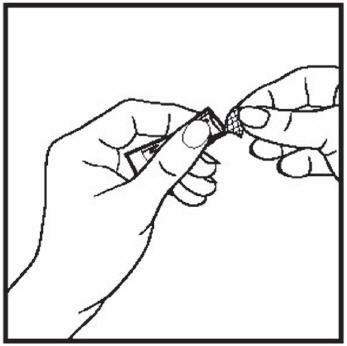
Figure A
Step 4: Using your thumb and pointer (index) finger, squeeze the entire contents of the estradiol gel packet onto the skin of the upper thigh as shown in Figure B.
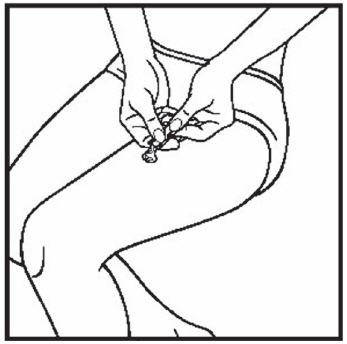
Figure B
Step 5: Gently spread the gel in a thin layer on your upper thigh over an area of about 5 by 7 inches, or two palm prints as shown in Figure C. It is not necessary to massage or rub in estradiol gel.
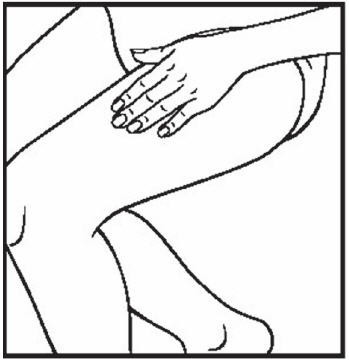
Figure C
Step 6: Allow the gel to dry completely before dressing.
Step 7: Throw away (dispose) of the empty estradiol gel packet in the trash.
Step 8: Wash your hands with soap and water immediately after applying estradiol gel to remove any remaining gel and reduce the chance of transferring estradiol gel to other people.
Important things to remember when using estradiol gel
- Allow the gel to dry before dressing. Try to keep the area dry for as long as possible.
- Do not allow another person to come in contact with the area of skin where you applied the gel for at least 1 hour after you apply estradiol gel.
- You should not have another person to apply the gel for you. However, if you need to have another person help you, have that person wear a disposable plastic glove to avoid direct contact with estradiol gel.
- Do not apply estradiol gel to your face, breast, or irritated skin.
- Never apply estradiol gel in or around the vagina.
- Estradiol gel contains alcohol. Alcohol based gels are flammable. Avoid fire, flame or smoking until the gel has dried.
What should I do if I miss a dose?
If you miss a dose, do not double the dose on the next day to catch up. If your next dose is less than 12 hours away, it is best just to wait and apply your normal dose the next day. If it is more than 12 hours until the next dose, apply the dose you missed and resume your normal dosing the next day. Do not apply estradiol gel more than 1-time each day. If you accidentally spill some of the contents of an estradiol gel packet, do not open a new estradiol gel packet. Wait and apply your normal dose the next day.
What should I do if someone else is exposed to estradiol gel?
To reduce the chance of transfer to another person (or pet) let the estradiol gel dry completely. Wash your hands with soap and water after application. If someone else is exposed to estradiol gel by direct contact with the wet gel, have that person wash the area of contact with soap and water right away. This is especially important for men and children. The longer the gel is in contact with the skin before washing, the greater the chance that the other person (or pet) will absorb some of the estrogen hormone. This may harm them. In case of any signs or symptoms of estrogen exposure in the other person (or pet), contact your healthcare provider (or veterinarian, if appropriate).
What should I do if I get estradiol gel in my eyes?
If you get estradiol gel in your eyes, flush your eyes right away with lukewarm tap water. If you have concerns, contact your healthcare provider.
What are the possible side effects of estradiol gel?
Side effects are grouped by how serious they are and how often they happen when you are treated.
Serious, but less common side effects include:
- heart attack
- stroke
- blood clots
- breast cancer
- cancer of the lining of the uterus (womb)
- cancer of the ovary
- dementia
- high or low blood calcium (hypercalcemia)
- gall bladder disease
- visual abnormalities
- high blood pressure
- high levels of fat (triglycerides) in your blood
- liver problems
- changes in your thyroid hormone levels
- fluid retention
- cancer change of endometriosis
- enlargement of benign tumors of the uterus (“fibroids”)
- worsening swelling of face and tongue (angioedema)
- changes in certain laboratory test results such as high blood sugar
Call your healthcare provider right away if you get any of the following warning signs or any other unusual symptoms that concern you:
- new breast lumps
- unusual vaginal bleeding
- changes in vision or speech
- sudden new severe headaches
- severe pains in your chest or legs with or without shortness of breath, weakness, and fatigue
- swelling of face, lips, and tongue with or without red, itchy bumps
The most common side effects of estradiol gel include:
- irregular vaginal bleeding or spotting
- breast tenderness
- vaginal yeast infection
- upper respiratory tract (nose, sinuses, pharynx or larynx) infection
These are not all the possible side effects of estradiol gel. For more information, ask your healthcare provider or pharmacist for advice about side effects. Tell your healthcare provider if you have any side effects that bother you or do not go away. You may report side effects to FDA at 1-800-FDA-1088 or Trigen Laboratories, LLC at 1-800-444-5164.
What can I do to lower my chances of a serious side effect with estradiol gel?
- Talk with your healthcare provider regularly about whether you should continue using estradiol gel.
- If you have a uterus, talk to your healthcare provider about whether the addition of a progestogen is right for you.
- In general, the addition of a progestogen is recommended for a woman with a uterus to reduce the chance of getting cancer of the uterus (womb). See your healthcare provider right away if you get vaginal bleeding while using estradiol gel.
- Have a pelvic exam, breast exam and mammogram (breast X-ray) every year unless your healthcare provider tells you something else.
- If members of your family have had breast cancer or if you have ever had breast lumps or an abnormal mammogram, you may need to have breast exams more often.
- If you have high blood pressure, high cholesterol (fat in the blood), diabetes, are overweight, or if you use tobacco, you may have higher chances of getting heart disease.
Ask your healthcare provider for ways to lower your chances of getting heart disease.
How should I store estradiol gel?
Store estradiol gel packets at room temperature, 68 to 77°F (20 to 25°C).
Keep estradiol gel and all medicines out of the reach of children.
General information about safe and effective use of estradiol gel.
Medicines are sometimes prescribed for purposes other than those listed in a Patient Information leaflet. Do not use estradiol gel for a condition for which it was not prescribed. Do not give estradiol gel to other people, even if they have the same symptoms that you have. It may harm them.
This leaflet provides a summary of the most important information about estradiol gel. If you would like more information, talk with your healthcare provider or pharmacist. You can ask your healthcare provider or pharmacist for information about estradiol gel that is written for health professionals.
What are the ingredients in estradiol gel?
Active ingredient: estradiol.
Inactive ingredients: carbomer, ethanol, propylene glycol, purified water, and triethanolamine.
How is estradiol gel supplied?
Estradiol gel is supplied in individual foil packets, each one containing a single day's dose.
Manufactured by:
Orion Corporation
Orion Pharma
Tengströminkatu 8
FI-20360 Turku
Finland
Manufactured for:
Trigen Laboratories, LLC
Alpharetta, GA 30005 USA
1-800-444-5164
Product of Finland
155330-10
Revised 11/2023
This Patient Information has been approved by the U.S. Food and Drug Administration.
- Using estrogen-alone increases your chance of getting cancer of the uterus (womb).
- PRINCIPAL DISPLAY PANEL 0.25 mg CARTON
- PRINCIPAL DISPLAY PANEL 0.5 mg CARTON
- PRINCIPAL DISPLAY PANEL 0.75 mg CARTON
- PRINCIPAL DISPLAY PANEL 1 mg CARTON
- PRINCIPAL DISPLAY PANEL 1.25 mg CARTON
-
INGREDIENTS AND APPEARANCE
ESTRADIOL
estradiol gelProduct Information Product Type HUMAN PRESCRIPTION DRUG Item Code (Source) NDC: 13811-090 Route of Administration TOPICAL Active Ingredient/Active Moiety Ingredient Name Basis of Strength Strength ESTRADIOL (UNII: 4TI98Z838E) (ESTRADIOL - UNII:4TI98Z838E) ESTRADIOL 0.25 mg in 0.25 g Inactive Ingredients Ingredient Name Strength CARBOMER HOMOPOLYMER TYPE B (ALLYL PENTAERYTHRITOL CROSSLINKED) (UNII: HHT01ZNK31) CARBOMER HOMOPOLYMER TYPE C (UNII: 4Q93RCW27E) ALCOHOL (UNII: 3K9958V90M) PROPYLENE GLYCOL (UNII: 6DC9Q167V3) WATER (UNII: 059QF0KO0R) TROLAMINE (UNII: 9O3K93S3TK) Packaging # Item Code Package Description Marketing Start Date Marketing End Date 1 NDC: 13811-090-32 30 in 1 CARTON 10/10/2022 1 0.25 g in 1 PACKET; Type 0: Not a Combination Product Marketing Information Marketing Category Application Number or Monograph Citation Marketing Start Date Marketing End Date NDA NDA022038 10/10/2022 ESTRADIOL
estradiol gelProduct Information Product Type HUMAN PRESCRIPTION DRUG Item Code (Source) NDC: 13811-091 Route of Administration TOPICAL Active Ingredient/Active Moiety Ingredient Name Basis of Strength Strength ESTRADIOL (UNII: 4TI98Z838E) (ESTRADIOL - UNII:4TI98Z838E) ESTRADIOL 0.5 mg in 0.5 g Inactive Ingredients Ingredient Name Strength CARBOMER HOMOPOLYMER TYPE B (ALLYL PENTAERYTHRITOL CROSSLINKED) (UNII: HHT01ZNK31) CARBOMER HOMOPOLYMER TYPE C (UNII: 4Q93RCW27E) ALCOHOL (UNII: 3K9958V90M) PROPYLENE GLYCOL (UNII: 6DC9Q167V3) WATER (UNII: 059QF0KO0R) TROLAMINE (UNII: 9O3K93S3TK) Packaging # Item Code Package Description Marketing Start Date Marketing End Date 1 NDC: 13811-091-32 30 in 1 CARTON 10/10/2022 1 0.5 g in 1 PACKET; Type 0: Not a Combination Product Marketing Information Marketing Category Application Number or Monograph Citation Marketing Start Date Marketing End Date NDA NDA022038 10/10/2022 ESTRADIOL
estradiol gelProduct Information Product Type HUMAN PRESCRIPTION DRUG Item Code (Source) NDC: 13811-093 Route of Administration TOPICAL Active Ingredient/Active Moiety Ingredient Name Basis of Strength Strength ESTRADIOL (UNII: 4TI98Z838E) (ESTRADIOL - UNII:4TI98Z838E) ESTRADIOL 1 mg in 1 g Inactive Ingredients Ingredient Name Strength CARBOMER HOMOPOLYMER TYPE B (ALLYL PENTAERYTHRITOL CROSSLINKED) (UNII: HHT01ZNK31) CARBOMER HOMOPOLYMER TYPE C (UNII: 4Q93RCW27E) ALCOHOL (UNII: 3K9958V90M) PROPYLENE GLYCOL (UNII: 6DC9Q167V3) WATER (UNII: 059QF0KO0R) TROLAMINE (UNII: 9O3K93S3TK) Packaging # Item Code Package Description Marketing Start Date Marketing End Date 1 NDC: 13811-093-32 30 in 1 CARTON 10/10/2022 1 1 g in 1 PACKET; Type 0: Not a Combination Product Marketing Information Marketing Category Application Number or Monograph Citation Marketing Start Date Marketing End Date NDA NDA022038 10/10/2022 ESTRADIOL
estradiol gelProduct Information Product Type HUMAN PRESCRIPTION DRUG Item Code (Source) NDC: 13811-092 Route of Administration TOPICAL Active Ingredient/Active Moiety Ingredient Name Basis of Strength Strength Estradiol (UNII: 4TI98Z838E) (ESTRADIOL - UNII:4TI98Z838E) Estradiol 0.75 mg in 0.75 g Inactive Ingredients Ingredient Name Strength CARBOMER HOMOPOLYMER TYPE B (ALLYL PENTAERYTHRITOL CROSSLINKED) (UNII: HHT01ZNK31) CARBOMER HOMOPOLYMER TYPE C (UNII: 4Q93RCW27E) ALCOHOL (UNII: 3K9958V90M) PROPYLENE GLYCOL (UNII: 6DC9Q167V3) WATER (UNII: 059QF0KO0R) TROLAMINE (UNII: 9O3K93S3TK) Packaging # Item Code Package Description Marketing Start Date Marketing End Date 1 NDC: 13811-092-32 30 in 1 CARTON 10/10/2022 1 0.75 g in 1 PACKET; Type 0: Not a Combination Product Marketing Information Marketing Category Application Number or Monograph Citation Marketing Start Date Marketing End Date NDA NDA022038 10/10/2022 ESTRADIOL
estradiol gelProduct Information Product Type HUMAN PRESCRIPTION DRUG Item Code (Source) NDC: 13811-094 Route of Administration TOPICAL Active Ingredient/Active Moiety Ingredient Name Basis of Strength Strength ESTRADIOL (UNII: 4TI98Z838E) (ESTRADIOL - UNII:4TI98Z838E) ESTRADIOL 1.25 mg in 1.25 g Inactive Ingredients Ingredient Name Strength CARBOMER HOMOPOLYMER TYPE B (ALLYL PENTAERYTHRITOL CROSSLINKED) (UNII: HHT01ZNK31) CARBOMER HOMOPOLYMER TYPE C (UNII: 4Q93RCW27E) ALCOHOL (UNII: 3K9958V90M) PROPYLENE GLYCOL (UNII: 6DC9Q167V3) WATER (UNII: 059QF0KO0R) TROLAMINE (UNII: 9O3K93S3TK) Packaging # Item Code Package Description Marketing Start Date Marketing End Date 1 NDC: 13811-094-32 30 in 1 CARTON 10/10/2022 1 1.25 g in 1 PACKET; Type 0: Not a Combination Product Marketing Information Marketing Category Application Number or Monograph Citation Marketing Start Date Marketing End Date NDA NDA022038 10/10/2022 Labeler - Trigen Laboratories, LLC (830479668)
© 2025 FDA.report
This site is not affiliated with or endorsed by the FDA.
